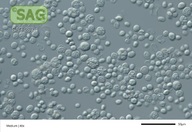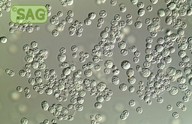| SAG Strain Number: | 263-1 |
| TAXONOMY |
| Genus: | Prototheca |
| Species: | zopfii |
| Taxonomic position: | Chlorophyta - Trebouxiophyceae |
| Authority: | Krüger |
| Variety: | |
| Formerly called: | authentic strain of Prototheca chlorelloides Beijerinck; SAG 263-1b |
| Authentic: | yes |
| Division: | Chlorophyta |
| Class: | Trebouxiophyceae |
| ORIGIN |
| General habitat: | |
| Climatic zone: | |
| Continent: | |
| Country: | |
| Locality: | |
| Lat. / Long. (Precision): | |
| Year: | before 1912 |
| Isolated by: | M. W. Beijerinck |
| Strain number by isolator: | as Prototheca chlorelloides Beijerinck |
| Deposition by: | CBS Delft NL to E.G. Pringsheim |
| Deposition date: | 1948 |
| CULTURE INFORMATION |
| Culture medium: | Malz Ag |
| Axenic: | axenic |
| Strain relatives: | UTEX 178 |
| Agitation resistance: | not detected |
| Special properties: | NO known Nagoya Protocol restrictions for this strain; colourless; potentially pathogenic! Risk Level 2 > restricted distribution! Handle with care! |
| |
| PUBLICATIONS |
| Publication: | Plieger T. et al. (2022) 18S and ITS2 rDNA sequence-structure phylogeny of Prototheca (Chlorophyta, Trebouxiophyceae). Biologia 77:569-582 |
| Publication: | Dziurzynski M. et al. (2021) Prototheca-ID: a web-based application for molecular identification of Prototheca species. Database 2021:baab073 |
| Publication: | Jagielski T. et al. (2019) The genus Prototheca (Trebouxiophyceae, Chlorophyta) revisited: Implications from molecular taxonomic studies. Algal Res. 43:101639 |
| Publication: | Figueroa-Martinez F. et al. (2015) When the lights go out: the evolutionary fate of free-living colorless green algae. New Phytologist 206 (3):972-982 |
| Publication: | von Bergen M. et al. (2009) Identification of harmless and pathogenic algae of the genus Prototheca by MALDI-MS. Proteomics Clin. Appl. 3:774–784 |
| Publication: | Huss, V.A.R. et al. (1999) Biochemical taxonomy and molecular phylogeny of the genus Chlorella sensu lato (Chlorophyta). J. Phycol. 35:587-598 |
| Publication: | Sarcina M. et al. (1995) DEGRADATION OF ADENINE BY PROTOTHECA ZOPFII (CHLOROPHYTA). Journal of Phycology 31 (4):575-576 |
| Publication: | Reisser W. et al. (1986) Studies on ultrastructure and host range of a Chlorella attacking virus. Protoplasma 135 (2):162-165 |
| Publication: | Kerfin W. et al. (1978) Physiological and Biochemical Contributions to the Taxonomy of the Genus Prototheca II. Starch Hydrolysis and Base Composition of DNA. Arch. Microbiol. 116 (1):105-107 |
| Publication: | Kessler E. (1977) Physiological and Biochemical Contributions to the Taxonomy of the Genus Prototheca I. Hydrogenase, Acid Tolerance, Salt Tolerance, Thermophily, and Liquefaction of Gelatin. Arch. Microbiol. 113:139-141 |
| Publication: | Pringsheim, E.G. (1963) Farblose Algen. Ein Beitrag zur Evolutionsforschung. Farblose Algen. Ein Beitrag zur Evolutionsforschung |
| Publication: | Beijerinck, M.W. (1912) Mutation bei Mikroben. In: Beijerinck, M.W. et al. [Eds.] Folia microbiologica: Holländische Beiträge zur gesamten Mikrobiologie I |
| show more publications ... |
| SEQUENCE INFORMATION |
| Sequence Accession: | MK452805 Prototheca zopfii strain SAG 263-1 cytochrome b (cytB) gene, partial cds; mitochondrial. (599 bp) |
| Sequence Accession: | MK445190 Prototheca moriformis strain SAG 263-1 small subunit ribosomal RNA gene, partial sequence. (1808 bp) |
| Sequence Accession: | MK445154 Prototheca moriformis strain SAG 263-1 small subunit ribosomal RNA gene, partial sequence; internal transcribed spacer 1, 5.8S ribosomal RNA gene, and internal transcribed spacer 2, complete sequence; and large subunit ribosomal RNA gene, partial seq (869 bp) |
| Sequence Accession: | X74006 P.zopfii plastid gene for 18S small subunit rRNA. (1515 bp) |
| Sequence Accession: | AB097097 Prototheca zopfii gene for 28S rRNA, partial sequence. (586 bp) |
| Sequence Accession: | X63519 18S rRNA gene (1809 bp) |
| show more sequences ... |
| CRYO |
| Cryopreservation: | standard 5% DMSO; very good survival |
| TEACHING |
| Recommended for teaching: | yes |


